Film of the Week: The Greasy Strangler
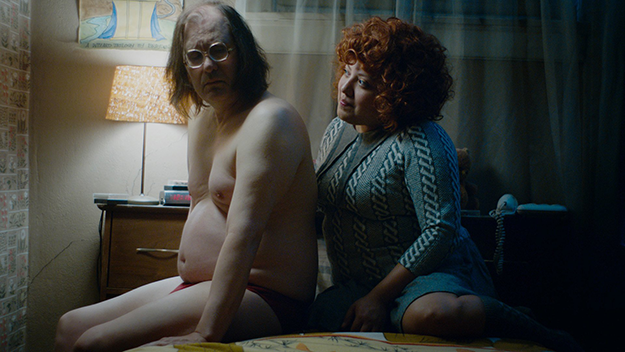
This week, I was going to review André Téchiné’s Being 17. It’s a mature, elegantly scripted, beautifully cast, altogether intelligent and sensitive piece of work. But a critic cannot live on French intelligence and sensitivity alone, so instead I’m going to write about a fairly inane, willfully repellent film called The Greasy Strangler. It’s about a man who coats himself from head to foot in grease and strangles people. We never find out why: it’s just what he does. And we never really understand the reason for the grease: it surely can’t help in getting a grip, but still, it never seems to be a problem.
I sometimes come out of films and hear people say, “That was completely pointless. I mean, what was the point of that?” Now, I don’t believe that any film is ever completely pointless; if the filmmakers did it entirely for their own amusement, that’s point enough. But The Greasy Strangler may be as close to a purely pointless film as any I’ve seen. Or perhaps, rather than “pointless,” an intelligent, sensitive French critic might prefer the word “gratuitous,” which suggests a certain amount of existential nobility—an elevated just-for-the-hell-of-it quality.
Made by British filmmaker Jim Hosking, who co-wrote it with Toby Harvard, The Greasy Strangler is clearly a film that its creators made for their own amusement, presumably figuring that if anyone else got a kick out of it, that would be a bonus but not essential. Premiered in Sundance this year, Hosking’s film sparked a controversy of sorts: Variety’s Dennis Harvey detected “a sense of absurdism that stubbornly remains on the peepee/caca level,” and The Hollywood Reporter (John DeFore) commented, “in addition to being repulsive it’s a witless bore”; conversely, IndieWire’s Russ Fischer hailed it as “a new event movie for the truly weird at heart” and Jordan Hoffman, in the Guardian, found it “a welcome oasis of filth, depravity and shock in a culture that too often thinks merely being a little weird passes muster.”
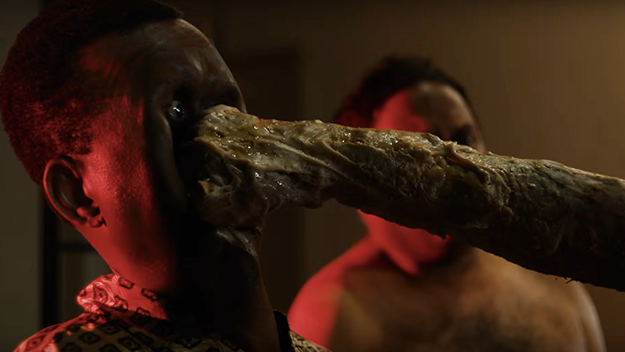
Personally, I’m neither for nor against The Greasy Strangler: I couldn’t honestly say your life would be the poorer for missing it, and if you asked me whether you should see it or the Téchiné, the very fact that you asked would make it clear that The Greasy Strangler is not for you. I’m not even sure that it’s for me; at my age (but let’s not go there), I have to say that when it comes to outré movies, my life’s-too-short reflex kicked in years ago. Still, The Greasy Strangler made me laugh aloud several times—not LOL uproarious guffaws, you understand, more like the odd incredulous, semi-delighted snort. And the film has stuck with me since then, partly as a result of trying to describe it to baffled friends.
Briefly, the film is about an abject, spectacularly dysfunctional father-son duo and their grotesque home life (Mom long ago ran away with one Ricky Prickles). Big Brayden (Sky Elobar) is the shy, put-upon, hapless middle-aged son, the dictionary definition of “schlub”: he resembles a giant wax pear that’s been left to melt by the fire. His father, Big Ronnie (played by 72-year old Michael St. Michaels), is a priapic, domineering blowhard with a foghorn voice and a shock of white hair. Big Ronnie insists on having grease, lots of it, with all his food and even drink—“Why not put a little grease in your java?”—and, at the start of the film, taunts Brayden with the possibility that he is the notorious Greasy Strangler who’s been haunting the neighborhood. Indeed, he is. We soon see Big Ronnie lumbering around naked, long stringbean penis a-dangle, coated from head to foot in lard; in fact, St. Michaels wears a strange prosthetic simulated-grease bodysuit that makes him resemble an oleaginous mummy.
By day, the duo dress in Schiaparelli pink pullovers and shorts and give disco tours of their neighborhood, pointing out such nondescript sites as the exact spot where the Bee Gees wrote ‘Night Fever’: “They wrote the lyrics while they were standing in this doorway.” “Can you verify that?” asks a dubious punter, and the tour devolves into a rancorous argument about there being no free drinks on offer.
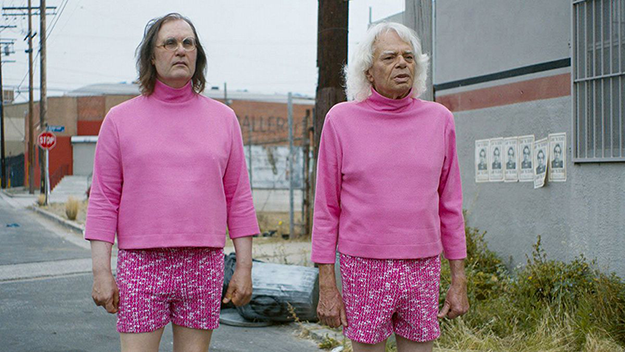
Things generally devolve in The Greasy Strangler, not least language. The script does not, let’s say, have the distrait eloquence of Eric Rohmer; it is, in terms of verbal comedy, what you might call headbanging. Repetition is of the essence. The “No free drinks!” riff goes on at punishing length, as does a sequence in which the disco tourists launch into a disquisition on the main ingredient of ridged paprika crisps (“Po’to!” “What?” “Po’to!”). Phrases return like mantras—“Bullshit artist!”, “You’re a smoothie!”, “You cheesy old cornball”—and more than once, we’re treated to a gratingly insistent chant of “Hootie tootie disco cutie!” The general tone is of malign, relentless idiocy, spiked by occasional run-that-by-me-again non sequiturs (Brayden’s pig-nosed buddy Oinker, asked where he got his shoes: “I’m renting them—and I’m absolutely loving it!”). And yet, in the year of the hyper-erudite Love & Friendship, I have to say there’s something enlivening about having your brain syringed by such material.
The Greasy Strangler revels in its own WTF-itude, which—as Jordan Hoffman’s review suggests—is a quality rarely found in authentic form these days. Everyone loves the idea of a genuinely bizarre film (even if they don’t always love watching one), and you always hope to discover a true UFO, a film inexplicable in normal terms, something that has emerged not only from outside the system, but from outside all reputable cinematic logic. You think of the films that came to constitute the revered “midnight movie” canon—Eraserhead, El Topo, early John Waters, Pink Flamingos—while perhaps the most credible recent example, at least in terms of pushing the limits of watchability, is Harmony Korine’s Trash Humpers, of which Hosking’s film vaguely resembles a de luxe remake.
But one of the defining qualities of such films is their outsider nature, in the sense that they seem to be made by people you can’t quite imagine operating in the film industry proper, nor living peacefully in the everyday world. They emerge from obsessions—you imagine Alejandro Jodorowsky, while dreaming up El Topo, unable to countenance a day that didn’t involve at least 10 dwarf amputees—and often from the shared obsessions of people inhabiting their own micro-counterculture, as in the Baltimore clique that produced Pink Flamingos.
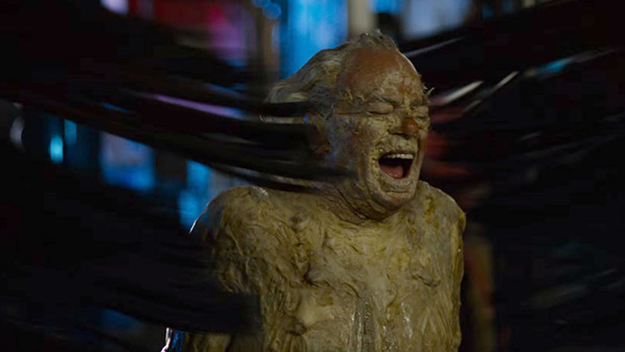
But outsider authenticity may no longer be strictly the mark of what used to be called “Incredibly Strange Films.” Whether or not British director Hoskins regards himself as an outsider, he’s quite an established figure as a maker of commercials, which usually feature uncomfortable-looking people with terrible hair. He also made the well-regarded short Renegades (2010) and a segment of this year’s horror portmanteau ABCs of Death 2. The Greasy Strangler is hardly an orphan movie from the wastelands—it has Elijah Wood as a producer, Ben Wheatley as an executive producer, and funding from no less august a body than the British Film Institute. It didn’t crawl out of a hole any more than the films of French expat director Quentin Dupieux (Rubber, Reality: textbook examples of weird that tries a little too hard).
In fact, the general professionalism and even elegance of The Greasy Strangler might make it seem, to people who insist on their weirdness raw, a little contrived. Sometimes it undeniably tries too hard: Andrew Hung’s music, with its varispeed Chipmunks voices and Residents/Ariel Pink goofiness, somewhat forces the joke. Nevertheless, elegance there is: as witness the repeated flurries of fast cutting every time Big Ronnie sheds his body grease in visits to the car wash. It has auteur coherence too. Hosking’s website proves that he’s a man who stays true to his obsessions. The Greasy Strangler has its own comic coherence: a style sustained throughout that’s best compared to a live-action cartoon. With a crew including DP Marten Tedin, production designer Jason Kisvarday, and costume designer Christina Blackaller, The Greasy Strangler seems to have been drawn with a scratchy nib and colored in with big, bright, ugly felt pen.
Its actors look like caricatures of themselves, or like figures in a Beavis & Butt-Head episode brought to life. Elizabeth De Razzo, who plays Janet, the sexpot ingénue whom both father and son fall for, is a roly-poly, big-eyed woman who resembles a lascivious carnival float of Li’l Orphan Annie. The men look variously decrepit, wizened, or just plain ungainly, and as the foul-mouthed, fouler-intentioned Big Ronnie, St. Michaels—previously best known for 1987’s The Video Dead—is a creature so bizarre he’s practically a mythical being. Hunched, lanky, with a lubricious cackle and a face like Ernest Borgnine’s after the moisturizer has run out, he plays a man who, when dressing for a night on the town, resembles a zombie version of Steve Tyler circa 1974: he sports a purple lamé pantsuit with a transparent crotch that’s a brazen shop-window for that obscene stringbean member. It’s a horrific sight, yet, when he’s slumping down the street and, suddenly caught in a spotlight, breaks into his goofy disco moves, it’s inexplicably funny, like Herman Munster going Travolta.
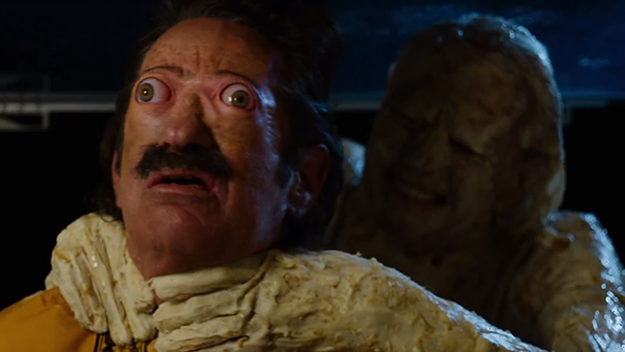
Much of the humor is not just greasy but grisly. The first routine with popping eyeballs will make you gulp—but it’s particularly funny because it’s set up at length by a character sitting down on a toilet in his mobile home and delicately propping up an open window behind him, as if to say, “You may strangle me now.” The humor is infantile, scatological, and undeniably misogynistic, although this is one of those touch-and-go cases that is so whole-heartedly misanthropic that accusations of misogyny seem redundant.
If I were to pull one of those “A cultural critic writes…” stunts on you, I’d be tempted to say that, quite apart from Trash Humpers (which I found genuinely, boringly unwatchable), The Greasy Strangler put me in mind of an older strain of gross-out humor, and an eminently canonical one. I’m thinking of Alfred Jarry’s 1896 play Ubu Roi, which horrified Paris audiences in 1896 with its Punch-and-Judy brutishness and its opening word, “Merdre!” (as it’s sometimes translated, “Shrit!”). I can’t say I loved The Greasy Strangler, nor hated it, and I’m probably too blasé to be really blindsided by a film like this. But it made me chuckle, made me wince a little—and it made me enjoy telling people about it and watching them squint dubiously at me as if they suspected me of making it all up. Anyway, I hope Jim Hosking doesn’t go on to have a cozy mainstream career: for better or worse, his heart clearly belongs with the greasy weird shrit.
Jonathan Romney is a contributing editor to Film Comment and writes its Film of the Week column. He is a member of the London Film Critics Circle.







